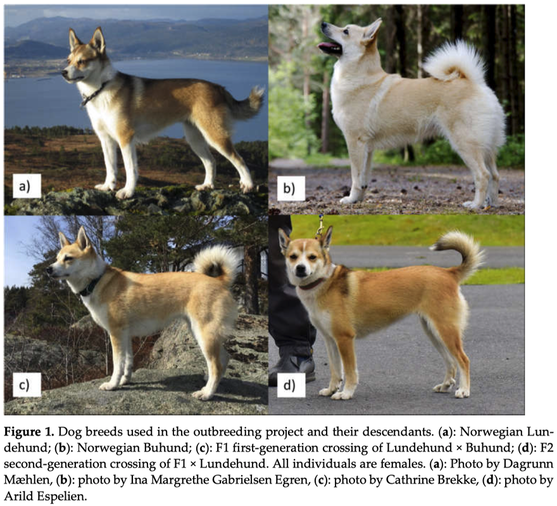Στο θέμα αναφέρθηκε και η Carol Beuchat στο ICB.
By Carol Beuchat PhD
www.instituteofcaninebiology.org
Μεταξύ άλλων αναφέρθηκε και στα Νορβηγικά Lundehunds στα οποία είχα αναφερθεί το '15 σε
αυτό το θέμα.
Αντιγράφω από κει:
"Το 1937 η Eleanor Christie στην Νότιο Νορβηγία, διαβάζοντας ένα άρθρο για την εν λόγω φυλή και τον κίνδυνο αφανισμού που διατρέχει, αποφάσισε να βρει κάποια για να αρχίσει την εκτροφή τους. Ετσι βρήκε έναν αγρότη από τα Νησιά Φεροε που το 1939 της έστειλε 4 κουτάβια. 3 θηλυκά και 1 αρσενικό.
Δυστυχώς όμως η μόρβα θέρισε τα Φεροε και τα γύρω νησιά με αποτέλεσμα το 1942 να έχει μείνει ΜΟΝΟ 1 σκύλος στα νησιά. Ο αγρότης που είχε στείλει τα κουτάβια του στην Christie επικοινώνησε μαζί της και εκείνη του έστειλε 2 σκύλες έγκυες και 2 κουτάβια.
Οι 2 τους κατάφεραν να ξαναζωντανέψουν κάπως την φυλή, στέλνοντας ο ένας σκύλους στον άλλον. Και τα κατάφεραν.
Το 2010 η φυλή αριθμούσε 1400 άτομα!"
Σκεφτείτε πως τα 1400 άτομα που αριθμούσε η φυλή το 2010, προέρχονται από τα γονίδια 5 (ΠΕΝΤΕ) σκύλων + τα κουτάβια που είχανε οι 2 έγκυες σκύλες.
Δεν είναι να απορεί λοιπόν κανείς που η φυλή οδηγήθηκε λόγω προβλημάτων υγείας και φυσικά της κλειστής δεξαμενής, σε πρόγραμμα εξωδιασταύρωσης.
17 Ιανουαρίου 2022, δημοσιεύτηκε μια
μελέτη της Claudia Melis με τίτλο "Genetic Rescue of the Highly Inbred Norwegian Lundehund", που εξετάζει το τί έγινε. Εχει ενδιαφέρον να την διαβάσετε.
Κάποια σημεία ενδεικτικά της κατάστασης:
• The small population suffered two bottlenecks in the 1940s and the 1960s,
which resulted in the Lundehund being among the dog breeds with the highest reported
inbreeding, as measured by microsatellite markers , single nucleotide polymorphisms
(SNPs) and genealogical data.
• Due to a major effort to rescue the breed, today, there are about 1500 Lundehund
individuals in the world, and about 900 of these live in Norway. (2021)
Therefore, the breed is not at immediate risk of extinction.
• However, the effective population size (Ne) of the global Lundehund population was
estimated to be very low based both on pedigree data (
Ne = 13) and on
molecular
data (
Ne = 28).
• Moreover, the Lundehund shows signs of inbreeding depression by reduced fertility due to small litter size, problems with mating behavior (probably due to inbreeding avoidance mechanisms) and low sperm quality. Additionally, the Lundehund has a predisposition to develop intestinal lymphangiectasia, a protein-losing enteropathy that can cause symptoms such as intermittent diarrhea, vomiting, weight loss and ascites, often reported as the “Lundehund syndrome” (hereafter LS). In addition, chronic atrophic gastritis and gastric neoplasms are common in dogs with LS.
For this reason, breeders inform future owners about potential symptoms that could
arise and require immediate veterinary treatment. Moreover, they advise new owners
to feed their dogs with a
diet low in fat content.
• Despite these preventive efforts, a study on mortality causes in the Lundehund conducted in 2010–2012 showed that 30% of deaths before 11 years of age occurred as a consequence of LS and another 10% of other gastrointestinal diseases. Moreover, many dogs experience several acute episodes of LS throughout their lives, which require expensive treatment and negatively affect their quality of life. The pattern of inheritance of LS is not well understood and might, at least in part, be explained by polygenic inheritance and a high frequency—or fixation—of the responsible gene(s).
Αυτά...
Τα υπόλοιπα στην μελέτη

Καλημέρα!

